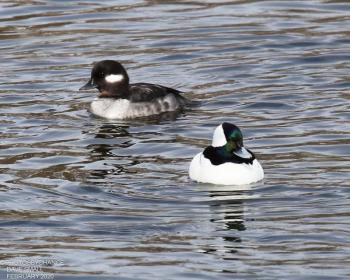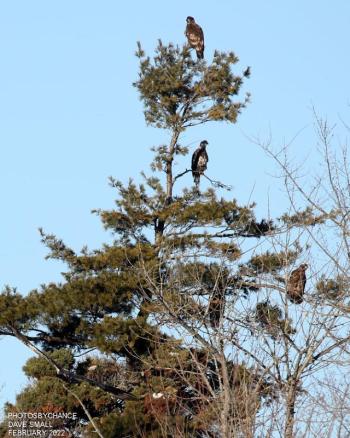‘Great’ Big Surprises
As we write this, the 2024 Great Backyard Bird Count is on its final day. Incredibly, the number of bird sighting checklists that have been submitted is closing in on a quarter of a million coming from more than 200 countries. At our last check of the stats, over 7,600 of the world’s 10,000 or so bird species have been reported, with the highest number of species from Colombia (1303), Ecuador (1059), and India (1026). The United States was in eighth place with 653 species. That’s despite being the country with the largest number of bird checklists submitted by far (132,000).
India, now the world’s most populous country, had the second highest number of Great Backyard Bird Count checklists submitted, with 45,000, followed by Canada with 19,000. We were a little surprised to see that 384 checklists had been submitted from China. Amazingly, 179 checklists were sent in from Antarctica! One from Greenland, too. There’s even a category called “High Seas” for people far out to sea but who still want to count the birds they see. Believe it or not, 11 checklists had been submitted in this category!
For us, this is all especially mind-blowing. We were reminiscing this weekend as we did our own Great Backyard Bird Count observations about the birth of this event. It was dreamed up as a joint project of the Cornell Lab of Ornithology and the National Audubon Society, with the first count launched in 1998. At the time, we were there at the Lab of Ornithology in the thick of it all. That first year, there was a small team of computer geeks working out of a trailer—not fabulous, mind-blowing facility you see when you visit CLO now. Back then, high- tech was nowhere near as high, and the cloud was for the most part still white puffs you saw in the sky. Our tech gurus had to be on their toes at all times to keep everything running smoothly as the reports came in across the U.S. and Canada. Amazingly, the system snagged only a few times. The team worked in shifts to ensure that the computer servers were properly monitored and that someone was ready to fix inevitable problems as they popped up. As far as we know, there is only a single person remaining at the Lab of Ornithology or Audubon who were major participants in that first year of Great Backyard Bird Count.
Everyone was astonished that first year by the number of checklists submitted and number of species tallied—a fraction of today’s numbers. And user questions are far fewer, as today’s birders are used to submitting their sightings through eBird, which entered the world after the GBBC. In essence, the early Great Backyard Bird Count system was the foundation on which eBird was built.
So you can see why the success of Great Backyard Bird Count across the globe is so amazing to us!
We still enjoy participating in the count and had our own local inspirations and surprises this year. The most astonishing was the unprecedented number of bald eagles we discovered along the banks of the Kennebec River in Gardiner. On Sunday, as we passed by the old stone “castle” on the Gardiner estate along the River Road, we saw a few bald eagles flapping low over the trees ahead. Getting closer, we saw eagles sitting in the trees beside the riverbank, groups of three and four sitting on the ice and along muddy banks—more and more and more. We were so shocked by the tally that we turned the car around and drove back by, this time at a crawl with the hazard lights on. We counted 30 bald eagles right there! We pulled into the Gardiner Waterfront Park and continued gazing as several more adults soared in very high from the north. This was all in a period of about 10 minutes. Crazy!
The Wiscasset waterfront gave us some cool birds, too, though we would have been entirely happy just to spend time in the sun looking out toward the scenic shores of Edgecomb and Westport Island. Along with the widespread wintering common loons, we saw several of the light-gray, thin-necked red-throated loons, their slim bills pointing up toward the sky. In our experience, red-throated loons seem to like this spot as do one of our favorite wintering bay ducks, the bufflehead. Groups from two to as many as ten or so of these little black-and-white ducks bobbed and dove across the expanse of water, especially north of the Route 1 bridge as viewed from near the water treatment plant. A careful scan with the telescope revealed at least 55 of this species that breeds in Canada’s Boreal Forest region. They come south to winter here in coastal Maine and across much of the U.S., south into Mexico.
Those are just a few of the memories and delights that Great Backyard Bird Count 2024 conjured up for us. We hope that you were inspired to get out and enjoy birds and nature this weekend as well. To check out results from across the world, here in the U.S., in Maine, or even right in Lincoln County (where 65 species had been tallied when we last checked) go to bird count.org and start exploring!
Jeffrey V. Wells, Ph.D., is a Fellow of the Cornell Lab of Ornithology and Vice President of Boreal Conservation for National Audubon. Dr. Wells is one of the nation's leading bird experts and conservation biologists. He is a coauthor of the seminal “Birds of Maine” book and author of the “Birder’s Conservation Handbook.” His grandfather, the late John Chase, was a columnist for the Boothbay Register for many years. Allison Childs Wells, formerly of the Cornell Lab of Ornithology, is a senior director at the Natural Resources Council of Maine, a nonprofit membership organization working statewide to protect the nature of Maine. Both are widely published natural history writers and are the authors of the popular books, “Maine’s Favorite Birds” (Tilbury House) and “Birds of Aruba, Bonaire, and Curaçao: A Site and Field Guide,” (Cornell University Press).





























